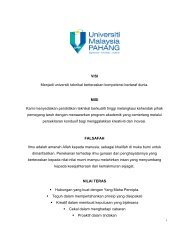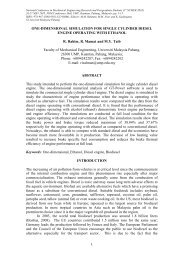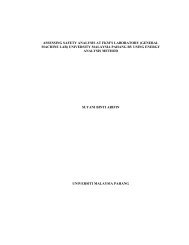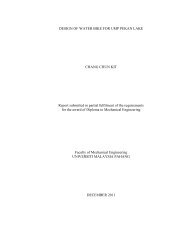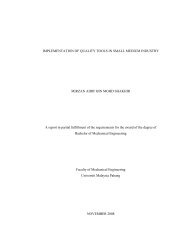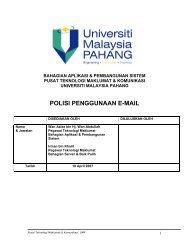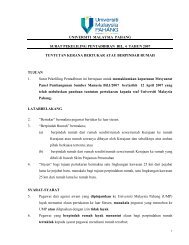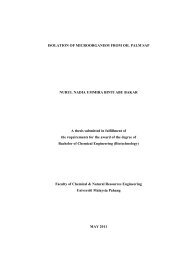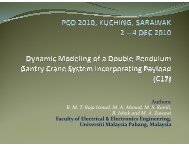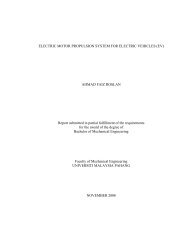extraction of gaharu essential oil using spinning band - UMP ...
extraction of gaharu essential oil using spinning band - UMP ...
extraction of gaharu essential oil using spinning band - UMP ...
Create successful ePaper yourself
Turn your PDF publications into a flip-book with our unique Google optimized e-Paper software.
EXTRACTION OF GAHARU ESSENTIAL OIL USING SPINNING BANDDISTILLATIONAHMAD FADZLI BIN ZAKARIAA thesis submitted in fulfillment<strong>of</strong> the requirements for the award <strong>of</strong> the degree <strong>of</strong>Bachelor <strong>of</strong> Chemical EngineeringFaculty <strong>of</strong> Chemical & Natural Resources EngineeringUniversity College <strong>of</strong> Engineering & Technology MalaysiaNovember, 2006
iiDECLARATIONI declare that this thesis entitled “Extraction <strong>of</strong> Gaharu Essential Oil Using SpinningBand Distillation.” is the result <strong>of</strong> my own research except as cited in references. Thethesis has not been accepted for any degree and is not concurrently submitted incandidature <strong>of</strong> any other degree.”Signature:……………………………………….Name <strong>of</strong> Candidate : Ahmad Fadzli Bin ZakariaDate : November 20 th , 2006
To God, my beloved mother, father, brothers, sister and friends…iii
ivACKNOWLEDGEMENTSIn preparing this thesis, I was in contact with many people, researchers,academicians and practitioners. They have contributed towards my understandingand thought during this project development. First <strong>of</strong> all praise and gratitude to AllahS.W.T for giving me strength for went through so many difficulties to successfullyfinishing up my project.In particular, I would like to express my appreciation to my main thesissupervisor, Ms. Mazni Binti Ismail and my co-supervisor, Mrs. Fatmawati BintiAdam for giving me guidance, advice and motivation. Without their continuoussupport and guideline, this thesis would not be success.For my parent especially my beloved mother and father, Mrs. Fatimah Bt.Mohd Salim and Mr. Zakaria B. Mohamad for their love and understandingthroughout this research process.I am also would like to express my appreciation and thanks to all lecturerfrom Chemical & Natural Resources Engineering ( FKKSA ) and MARDI staffespecially Mr. Malik for their support and knowledge in finishing this thesis.My fellow undergraduate friends especially Norhamly, Hafiz, Shahrizal andAzrul Hisyam should also be recognized for their support and for their time doingdiscussion to share the knowledge.
vABSTRACTGaharu is known as one <strong>of</strong> the most expensive wood in the world. Its<strong>essential</strong> <strong>oil</strong> is used in many industries such as perfume and also t<strong>oil</strong>etries. The<strong>gaharu</strong> that was used in this study is grade C <strong>gaharu</strong> from peninsular <strong>of</strong> Malysia(Aquiliria Malaccensis) or known as ‘karas’ among the locals. Traditionally, <strong>gaharu</strong><strong>oil</strong> is extracted by distilling the grinded <strong>gaharu</strong> sample in a copper still. However theprocess it is not effective and the yield <strong>of</strong> <strong>oil</strong> is relatively small and it acquire hightemperature. The <strong>extraction</strong> <strong>of</strong> <strong>gaharu</strong> <strong>essential</strong> <strong>oil</strong> <strong>using</strong> <strong>spinning</strong> <strong>band</strong> distillation(batch distillation) and water as solvent at heating rate and temperature cut rangingfrom 20 – 40% and 25 - 100˚C respectively was studied. The size <strong>of</strong> <strong>gaharu</strong> particlethat will be used is
viABSTRAKKayu Gaharu terkenal sebagai antara kayu yang termahal di dunia. Patiminyak yang dihasilkan dari kayu <strong>gaharu</strong> digunakan dalam banyak industri dansebagai juga dalam alat dandanan diri. Kayu Gaharu yang digunakan dalam kajian iniadalah daripada gred C dari semenanjung Malaysia (Aquiliria Malaccensis) ataulebih dikenali sebagai kayu karas dikalangan penduduk setempat. Secaratradisionalnya, pati minyak <strong>gaharu</strong> diekstrak dengan kayu <strong>gaharu</strong> yang telah dikisaritu di suling dengan menggunakan bekas yang diperbuat daripada kuprum. Walaubagaimanapun, cara ini tidak efektif dan pati minyak yang dihasilkan adalah terlalusedikit dengan memerlukan suhu yang tinggi. Pengekstrakan pati minyak <strong>gaharu</strong>menggunakan Penyulingan Lingkaran Berp<strong>using</strong> (Spinning Band Distillation) dan airsebagai pelarut pada kadar pemanasan dan potongan suhu pada 20 - 40% dan 25 -100˚C telah dikaji. Saiz kayu <strong>gaharu</strong> yang dikisar adalah
viiTABLE OF CONTENTSCHAPTER TITLE PAGEDECLARATIONDEDICATIONACKNOWLEDGEMENTABSTRACTABSTRAKTABLE OF CONTENTSLIST OF TABLESLIST OF FIGURESLIST OF APPENDICESiiiiiivvviviixxixii1 INTRODUCTION1.1 Introduction 11.2 Objective <strong>of</strong> Study 31.3 Scope <strong>of</strong> Study 31.4 Problem statement 42 LITERATURE REVIEW2.1 Gaharu 52.2 Grading and Prizing <strong>of</strong> <strong>gaharu</strong> 6
viii2.3 Malaysia Scenario on Gaharu 72.4 Chemical Component <strong>of</strong> Gaharu Essential Oil 82.4.1 Chemical Structure <strong>of</strong> Gaharu 9Essential Oil Component2.5 Type <strong>of</strong> Extraction Method 102.5.1 Spinning Band Distillation 112.5.1.1 Spinning Band 122.5.2 Supercritical Fluid Extraction 132.5.3 Steam Distillation 132.5.4 Cold Pressing 142.5.5 Enfleurage 152.5.6 Solvent Extraction 153 METHODOLOGY3.1 Introduction 173.2 Drying 173.3 Grinding 183.4 Soaking 183.5 Spinning Band Distillation 183.6 Yield 204 RESULT & DISCUSSION4.1 Introduction 224.2 Preliminary Experiment 224.3 Extraction Result 254.4 Discussion 29
ix5 CONCLUSION5.1 Conclusion 315.2 Recommendation 31REFERENCES 33APPENDIXAppendix A Gantt Chart 35
xLIST OF TABLESTABLE NO. TITLE PAGE1.1 Scientific Classification Of Gaharu/Agarwood 13.1 Summarize data set <strong>of</strong> experiment 193.2 Planning <strong>of</strong> <strong>extraction</strong> 204.1 Parameter for preliminary experiment 1 234.2 Parameter for preliminary experiment 2 234.3 Parameter for preliminary experiment 3 244.4 Result for 20% heating rate and temperature cut 25between 25°C -65°C4.5 Result for 20% heating rate and temperature cut 26between 60°C -100°C4.6 Result for 30% heating rate and temperature cut 27between 60°C -100°C4.7 Result for 40% heating rate and temperature cut 28between 60°C -100°C
xiLIST OF FIGURESFIGURE TITLE PAGE1.1 Traditional water distillation 21.2 Copper Still 32.1 Large pieces <strong>of</strong> <strong>gaharu</strong> for sale 72.2 ‘Backyard’ industry in Kelantan 82.3 Khusenol 92.4 Agarospirol 92.5 Jinkoheremol 102.6 Jinkohol 102.7 Spinning Band 122.8 The Supercritical Fluid Extraction Process 133.1 Flow diagram <strong>of</strong> the <strong>extraction</strong> process 21
xiiLIST OF APPENDICESAPPENDIX TITLE PAGEA Equipment and solution b<strong>oil</strong>ing 35
CHAPTER 1INTRODUCTION1.1 IntroductionAgarwood or eaglewood (Gaharu) is one <strong>of</strong> the most expensive wood in theworld. It is the occasional product <strong>of</strong> two to four genera in the familyThymelaeaceae, with Aquilaria agallocha and Aquilaria malaccensis the best knownspecies. The strong heavy scent <strong>of</strong> <strong>gaharu</strong> is unique and complex. Gaharu is afragrant wood that has been traded since biblical times for its use in religious,medicinal and aromatic preparations (Zich et al., 2001).Table 1.1: Scientific Classification Of Gaharu/AgarwoodKingdom PlantaeDivision MagnoliophytaClass: MagnoliopsidaOrder: MalvalesFamily: ThymelaeaceaGenus: Aquilaria(Source : www.wikipedia.org)
2Gaharu <strong>essential</strong> <strong>oil</strong> is highly prized for the scent produced and the <strong>oil</strong> is usedin perfume and t<strong>oil</strong>etry product such as soap, shampoo and etc . Generally, <strong>gaharu</strong><strong>oil</strong>s are mixture <strong>of</strong> sesquiterpenes, sesquiterpene alcohols, oxygenated compounds,chromone derivatives and resin (Chang et al., 2002). Plant extracts as seen as a way<strong>of</strong> meeting the demanding requirement <strong>of</strong> the modern industry for the past twodecades (Simandi et al., 1996).There are many method that had been done since 1943 to get the <strong>gaharu</strong><strong>essential</strong> <strong>oil</strong>. M.A. Rahman in1980 have tried the artificial inoculation and woundingtechnique to the tree in order for the tree to produce aromatic base oleoresin (M.A.Rahman et al., 1980). In Malaysia, the research on <strong>gaharu</strong> and also the extracting <strong>of</strong><strong>gaharu</strong> <strong>essential</strong> <strong>oil</strong> have been done by Forest Research Institute <strong>of</strong> Malaysia (FRIM).Base on Chang et al., <strong>gaharu</strong> <strong>essential</strong> <strong>oil</strong> usually obtained by distillation method. Forsmall scale industries that concentrate on extracting the <strong>oil</strong>, they were <strong>using</strong> waterdistillation technique in a copper still. The problems <strong>of</strong> this technique are lowefficiency and acquire high and continuous heating and required long <strong>extraction</strong> time.Figure 1.1: Traditional water distillation
3Figure 1.2: Copper Still1.2 ObjectiveTo examine the feasibility <strong>of</strong> Spinning Band Distillation as an improvedmethod for <strong>gaharu</strong> <strong>oil</strong> <strong>extraction</strong> process.1.3 Scope Of StudyIn order to achieve the objective, the following scopes have been identifiedand to be applied:1. To study the effect <strong>of</strong> heating rate on <strong>gaharu</strong> <strong>essential</strong> <strong>oil</strong> <strong>extraction</strong>ranging from 20% to 40% <strong>of</strong> heating mantle power.2. To study the effect <strong>of</strong> temperature cut on <strong>gaharu</strong> <strong>essential</strong> <strong>oil</strong> <strong>extraction</strong>.
41.4 Problem StatementCurrent method <strong>of</strong> extracting <strong>gaharu</strong> <strong>essential</strong> <strong>oil</strong> is <strong>using</strong> traditional waterdistillation method (Chang et al., 2002) or hydrodistillation. This <strong>extraction</strong> methodacquires long <strong>extraction</strong> times that consume a lot <strong>of</strong> fuel for heating purposes. The<strong>extraction</strong> process didn’t produce the maximum yield <strong>of</strong> <strong>oil</strong> from the wood becausethe efficiency <strong>of</strong> the method itself is relatively low. All this will result in higheroperating cost especially for heating process.Another problem is current method also including the <strong>extraction</strong> <strong>using</strong>solvent. Even though it take shorter time than the hydrodistillation, the <strong>oil</strong> producedby this method is not suitable for skin use (Wilson, 1995). Gaharu <strong>essential</strong> <strong>oil</strong> alsobeing used in t<strong>oil</strong>etries product. If this <strong>oil</strong> is to be in the t<strong>oil</strong>etries market, it requiresother <strong>extraction</strong> method..
CHAPTER 2LITERATURE REVIEW2.1 GaharuGaharu or agarwood is the resin-impregnated heartwood <strong>of</strong> Aquilaria species<strong>of</strong> the family Thymalaeaceae. It gives <strong>of</strong>f a unique aromatic scent when the wood isburnt. The odor <strong>of</strong> agarwood is complex and pleasing, with few or no similar naturalanalogues. As a result, agarwood and its <strong>essential</strong> <strong>oil</strong> gained great cultural andreligious significance in ancient civilizations around the world. Generally agreed tobe the result <strong>of</strong> a pathological condition, <strong>gaharu</strong> aromatic resin is produced as the treesap thickens in response to injury and fungal infection.The degree to which the resin saturates the heartwood phloem fibersdetermines the market value <strong>of</strong> this product. In lesser quality specimens, the resincreates a mottled or speckled appearance in the naturally pale wood, but higherquality specimens are nearly solid in color—glossy and black (Donovan et al., 2004).There are no less than twenty names associated with it, and this reflects its long storyand widespread usage. Some other names for <strong>gaharu</strong> include agaru, aloes wood,eagle wood, oud, chen-xiang (in Chinese it means ‘incense that sink’), jinkoh and soon (Chang et al., 2002). Agarwood has been used for traditional medicine in Japan onaccount <strong>of</strong> its effectiveness as a sedative or tranquilizer, in detoxifying the body andin maintaining stomach health (Compton et al., 2005).
62.2 Grading and Prizing <strong>of</strong> GaharuAs noted by Barden et al., grading <strong>gaharu</strong> is a complicated process. Thisincludes evaluating the size, colour, odour, weight (on scale and in water) andflammability <strong>of</strong> the wood. The application <strong>of</strong> grade codes (super A, A, B, C, D andE) varies between buyers.Resin content <strong>of</strong> <strong>gaharu</strong> is <strong>of</strong>ten tested by igniting the wood and smelling thesmoke, while watching for bubling <strong>of</strong> resin as the wood burns. When there is a largeamount <strong>of</strong> <strong>gaharu</strong> to be graded, buyers <strong>of</strong>ten make the first sort by <strong>using</strong> water test,separating pieces that float (because <strong>of</strong> lower resin content) from those that sink(high resin content) from those that sink (high resin content, better quality). Afterthey are dried again, pieces are graded based on colour and size (Zich et al., 2001).The grading given an individual is different from others because they totallydepend on their senses and sense between human are different. Different people givedifferent grade values. This is always the problem because there is no standard onstandardizing the grade <strong>of</strong> <strong>gaharu</strong>.According to Zich et al., 2001, price per kilogram in May 2001 averaged asfollows:A grade = USD 341B grade = USD 237C grade = USD 172D grade = USD 111
7Figure 2.1: Large pieces <strong>of</strong> <strong>gaharu</strong> for sale(Source : James Compton/T-OC/WWF SPP)2.3 Malaysia Scenario on GaharuThe majority <strong>of</strong> <strong>gaharu</strong> <strong>essential</strong> <strong>oil</strong> <strong>extraction</strong> in Malaysia happens isKelantan where the villagers doing it as ‘backyard’ industry. They use waterdistillation method for that purpose. The process <strong>of</strong> extracting the <strong>oil</strong> takes until 96hours <strong>of</strong> distillation process.High quality <strong>gaharu</strong> can reach up to RM10,000 per kg and is burned like anincense stick. A 12g bottle <strong>of</strong> <strong>oil</strong> is sold at between RM50 and RM200. Because <strong>of</strong>the use <strong>of</strong> <strong>gaharu</strong> to get the fragrant <strong>oil</strong> is huge, high-grade Aquilaria resin had grownrare and demand was low for the lower grade chips that collectors were producing. A21 <strong>extraction</strong> pot factory will use up to a tonne <strong>of</strong> wood per month. This shows howintense <strong>gaharu</strong> usage for one factory alone.
8Figure 2.2: ‘Backyard’ industry in KelantanThe federal Forestry Department has since then urged state governments toregulate the collection, trade and processing <strong>of</strong> agarwood through a licensing system.It also recommended issuing only one harvesting licence for each forestry district(different from administrative district).Gaharu collectors or buyers have to pay a royalty fee amounting to 10% <strong>of</strong>the raw material market price. An <strong>extraction</strong> permit is issued and this will facilitatethe traders in obtaining export and Cites (Convention on International Trade inEndangered Species) permit (Hillary Chiew 2005).2.4 Chemical Component <strong>of</strong> Gaharu Essential OilGenerally, <strong>gaharu</strong> <strong>oil</strong>s are mixture <strong>of</strong> sesquiterpenes, sesquiterpene alcohols,oxygenated compounds, chromone derivatives and resins. Some <strong>of</strong> the moreimportant compounds are agarospirol, jinkohol-eremol, jinkohol and kusenol thatmay contribute to the characteristic aroma <strong>of</strong> <strong>gaharu</strong> (Nakanishi et al., 1984, Ishiharaet al., 1993). Other compounds such as 2-(2-4’-methoxyphenylethyl) chromone
9produce a long lasting fragrance upon burning. Chemical pr<strong>of</strong>ile for each grade suchas grade A, B and C were different. In peninsular <strong>of</strong> Malaysia, the <strong>gaharu</strong> weremostly <strong>of</strong> grade C quality. Gas chromatograms showed similar gas chromatographypr<strong>of</strong>ile suggesting a region <strong>of</strong> peaks with retention times ranging from 28.0 to 42.0min to be indicative <strong>of</strong> <strong>gaharu</strong> presence (Chang et al., 2002).2.4.1 Chemical Structure <strong>of</strong> Gaharu Essential Oil ComponentDifferent chemical component in <strong>gaharu</strong> <strong>oil</strong> will determine the characteristicor quality <strong>of</strong> the <strong>gaharu</strong>. Figures below will show some chemical componentstructure in <strong>gaharu</strong> <strong>essential</strong> <strong>oil</strong>.KhusenolIUPAC: 2-(2,4-dihydroxyphenyl)-3,7-dihydroxy-8-(5--elicoid-5-methyl-2-prop-1-en-2-yl-hexyl)-5-methoxy-chroman-4-oneMW : 472.527 g/molFigure 2.3: KhusenolAgarospirolIUPAC: 2-(6,10-dimethyl-2-spiro[4.5]dec-9-enyl)propan-2-olMW : 222.366 g/molFigure 2.4: Agarospirol
10JinkoheremolIUPAC: 2-(8,8a-dimethyl-2,3,4,6,7,8-hexahydro-1H--elicoids-e-2-yl)propan-2-olMW : 222.366 g/molFigure 2.5: JinkoheremolJinkoholMF : C 15 H 26 OMW : 222.366 g/molFigure 2.6: Jinkohol(Source: http://pubchem.ncbi.nlm.nih.gov)2.5 Types <strong>of</strong> Extraction Method2.5.1 Spinning Band DistillationOne specific type <strong>of</strong> distillation apparatus which spins a <strong>band</strong> throughout amajor portion <strong>of</strong> the length <strong>of</strong> the column is called the ‘<strong>spinning</strong> <strong>band</strong> distillation’.Generally, the <strong>spinning</strong> <strong>band</strong>s incorporated in these types <strong>of</strong> distilling columns takeon a spirally wound shape, and are just wide enough to lightly scrape the surroundingwalls <strong>of</strong> the column when they are rotated. The spiral shape, giving the <strong>band</strong> theappearance <strong>of</strong> elongated helicoids, produces an axial thrust as the <strong>band</strong> is spun athigh rotation per minutes (r.p.m.). Thus, when rotated at high speeds and in theproper direction, these <strong>spinning</strong> <strong>band</strong>s force the reflux downward along the walls <strong>of</strong>the column in a quick and uniform manner. This latter feature is especially helpful in
11preventing these types <strong>of</strong> fractionating columns from flooding, even when operatedat high b<strong>oil</strong>-up rates (Roark et al., 1997).The major purpose <strong>of</strong> this equipment is to purify flavors, fragrances, naturalproduct, and <strong>essential</strong> <strong>oil</strong>s ranging from 1 to 50 liters capacity.The key features <strong>of</strong> this equipment include:a) High purity:The 50 theoretical plate fractional distillation column can produce high puritydistillates. For flavors, fragrance, natural products and <strong>essential</strong> <strong>oil</strong>s, even smallincrease in purity can translate to large increase in value.b) Low "hold up":The <strong>spinning</strong> <strong>band</strong> distillation column has less than 1.5 milliliters remaining behindin the column after the distillation is complete. This means that the smallest amount<strong>of</strong> valuable material possible is lost in the purification process.c) Low pressure drop:The <strong>spinning</strong> <strong>band</strong> distillation column has virtually no pressure drop from the top tothe bottom compared to a packed column. This can be a big advantage whendistilling delicate samples that decompose easily when heated too high.d) Automation:The 9600 fractional distillation system can be fully automated. Once the desiredparameters are programmed, the distillation proceeds without any operatorintervention, freeing up valuable operator time to perform other important work.
122.5.1.1 Spinning BandThere are two main types <strong>of</strong> <strong>spinning</strong> <strong>band</strong>s, Teflon and metal. Teflon<strong>spinning</strong> <strong>band</strong>s are the most common an have a maximum <strong>of</strong> 50 theoretical plates atatmospheric pressure. They are suitable for distilling solvents that can be distilled upto 225 ºC. Teflon is not suitable above this temperature because it becomes s<strong>of</strong>t andcan come apart under the <strong>spinning</strong> force.In situations where the b<strong>oil</strong>er temperature will go above 225 ºC a metal<strong>spinning</strong> <strong>band</strong> can be used. The most common metal used to make <strong>spinning</strong> <strong>band</strong>s isMonel. This is a stainless steel with a high content <strong>of</strong> molybdenum to maximizecorrosion resistance.Spinning BandFigure 2.7: Spinning Band(Source: www.brinstrument.com)
132.5.2 Supercritical Fluid ExtractionSupercritical Fluid Extraction (SFE) is the application <strong>of</strong> fluids in theirsupercritical state for <strong>extraction</strong> <strong>of</strong> components from solid materials. This is arelatively new process. This process gives a better quality extract but the capital costsare high. Carbon dioxide is usually used for solvent in this process. Its non-toxic andnon-combustible properties make it environmentally friendly.SFE is used for such application as the decaffeination <strong>of</strong> c<strong>of</strong>fee, <strong>extraction</strong> <strong>of</strong>fragrances for perfumes and <strong>extraction</strong> <strong>of</strong> active compounds from natural productsfor medical purposes. SFE allows for waste separation and minimization, as well assolvent recycling. Other advantages <strong>of</strong> supercritical <strong>extraction</strong> include highefficiency, high <strong>extraction</strong> rates and more selectivity.Figure 2.8: The Supercritical Fluid Extraction Process(Source: McGaw D.R. et al., 2000)2.5.3 Steam DistillationSteam distillation is the most common method <strong>of</strong> extracting <strong>essential</strong> <strong>oil</strong>s.Steam distillation is done in a still. Fresh or sometimes dried, botanical material isplaced in the plant chamber <strong>of</strong> the still, and pressurized steam is generated in aseparate chamber and circulated through the plant material. The heat <strong>of</strong> the steam
14forces the tiny intercellular pockets that hold the <strong>essential</strong> <strong>oil</strong>s to open and releasethem. The temperature <strong>of</strong> the steam must be high enough to open the pouches, yet notso high that it destroys the plants or fractures or burns the <strong>essential</strong> <strong>oil</strong>s.As they are released, the tiny droplets <strong>of</strong> <strong>essential</strong> <strong>oil</strong> evaporate and, togetherwith the steam molecules, travel through a tube into the still's condensation chamber.As the steam cools, it condenses into water. The <strong>essential</strong> <strong>oil</strong> forms a film on thesurface <strong>of</strong> the water. To separate the <strong>essential</strong> <strong>oil</strong> from the water, the film is thendecanted or skimmed <strong>of</strong>f the top.The remaining water, a byproduct <strong>of</strong> distillation, is called floral water,distillate, or hydrosol. It retains many <strong>of</strong> the therapeutic properties <strong>of</strong> the plant,making it valuable in skin care for facial mists and toners. In certain situations, floralwater may be preferable to pure <strong>essential</strong> <strong>oil</strong>, such as when treating a sensitiveindividual or a child, or when a more diluted treatment is required.2.5.4 Cold PressingAnother method <strong>of</strong> extracting <strong>essential</strong> <strong>oil</strong>s is cold pressed expression, orscarification. It is used to obtain citrus fruit <strong>oil</strong>s such as bergamot, grapefruit, lemon,lime, mandarin, orange, and tangerine <strong>oil</strong>s. In this process, fruit rolls over a troughwith sharp projections that penetrate the peel. This pierces the tiny pouchescontaining the <strong>essential</strong> <strong>oil</strong>. Then the whole fruit is pressed to squeeze the juice fromthe pulp and to release the <strong>essential</strong> <strong>oil</strong> from the pouches. The <strong>essential</strong> <strong>oil</strong> rises to thesurface <strong>of</strong> the juice and is separated from the juice by centrifugation.
152.5.5 EnfleurageSome flowers, such as jasmine or tuberose, have such low contents <strong>of</strong><strong>essential</strong> <strong>oil</strong> or are so delicate that heating them would destroy the blossoms beforereleasing the <strong>essential</strong> <strong>oil</strong>s. In such cases, an expensive and lengthy process calledenfleurage is sometimes used to remove the <strong>essential</strong> <strong>oil</strong>s. Flower petals are placedon trays <strong>of</strong> odorless vegetable or animal fat, which will absorb the flowers' <strong>essential</strong><strong>oil</strong>s. Every day or every few hours, after the vegetable or fat has absorbed as much <strong>of</strong>the <strong>essential</strong> <strong>oil</strong> as possible, the depleted petals are removed and replaced with freshones. This procedure continues until the fat or <strong>oil</strong> becomes saturated with the<strong>essential</strong> <strong>oil</strong>. Adding alcohol to this enfleurage mixture separates the <strong>essential</strong> <strong>oil</strong>from the fatty substance. Afterwards, the alcohol evaporates and only the <strong>essential</strong> <strong>oil</strong>remains.2.5.6 Solvent ExtractionAnother method <strong>of</strong> <strong>extraction</strong> used on delicate plants is solvent <strong>extraction</strong>,which yields a higher amount <strong>of</strong> <strong>essential</strong> <strong>oil</strong> at a lower cost. In this process, achemical solvent such as hexane is used to saturate the plant material and pull out thearomatic compounds. This renders a substance called a concrete. The concrete canthen be dissolved in alcohol to remove the solvent. When the alcohol evaporates, theabsolute remains.Although more cost-efficient than enfleurage, solvent <strong>extraction</strong> hasdisadvantages. Residue <strong>of</strong> the solvent may remain in the absolute and can cause sideeffects. While absolutes or concretes may be fine for fragrances or perfumes, they arenot especially desirable for skin care application.
CHAPTER 3METHODOLOGY3.1 IntroductionIn extracting <strong>gaharu</strong> <strong>essential</strong> <strong>oil</strong>, there are few processes that need to be donebefore extracting process. The extracting process will be run in different range <strong>of</strong>temperature cut and also different range heating rate to find the optimum condition toextract the <strong>oil</strong>.3.2 DryingDrying process need to be done so that the wood is completely dry from anymoisture before goes to the next step <strong>of</strong> experiment. It is also to get rid <strong>of</strong> anysubstance that can distract the impurities <strong>of</strong> <strong>oil</strong> when it has been extracted (Norazlina2005). The drying process in completed when the humidity inside the tray drier islonger falling. The air flow speed will be set at 1.44 meter per second (m/s) and thetemperature will be set at 60˚C.
183.3 GrindingThis is to give the maximum surface area for <strong>extraction</strong> process and tomaximize the contact time between the solvent and <strong>gaharu</strong> particle. In thisexperiment, the size <strong>of</strong> <strong>gaharu</strong> particle is prepared at 1.00mm. The large trunk <strong>of</strong><strong>gaharu</strong> need to be choped to a smaller size and before it can be grind.3.4 SoakingBefore the <strong>extraction</strong> process, grinded <strong>gaharu</strong> must be soaked in water. Theratio <strong>of</strong> <strong>gaharu</strong> to water is 1:7 (Dong-ping et al., 1999) for period <strong>of</strong> three to sevendays in order to break down the parenchymatous and <strong>oil</strong> glands (Chang et al., 2002).For this experiment seven days was chosen in order to maximize the soaking effect.The amount <strong>of</strong> <strong>gaharu</strong> sawdust used is 437.5 gram and water equal to 3062.5 mL.3.5 Spinning Band DistillationThe soaked <strong>gaharu</strong> then is put in the 5 liter heating pot and the temperaturecut and heating rate will be set.The range <strong>of</strong> temperature cut is around 25-100˚C. Heating rate that will beapplied ranging from 20-40% from total 600W <strong>of</strong> heating mantle power rate.Before the <strong>extraction</strong> time is recorded, the system will be leave to equilibriumstate that is around 15 minutes so that the <strong>extraction</strong> <strong>of</strong> the <strong>essential</strong> <strong>oil</strong> will be stable.The heating rate at each cut is the same with early heating rate so that the heatingprocess through the experiment is stable. Reflux ratio <strong>of</strong> each cut is set to zero so thatit can maximize the end product that is the <strong>essential</strong> <strong>oil</strong>. The end pot temperature isset not to exceed more than 15°C because almost all <strong>of</strong> the equipment is made from
19glass to prevent from cracking. Every experiment with the different range <strong>of</strong> datawill be run twice to duplicate the data.Below are the summarize data to be set for the experiment:Table 3.1: Summarize data set <strong>of</strong> experimentHeating rate X %Equilibrium15 minutesOpen cut 1 T a °CClose cut T b °CHeating rate 1 X %Reflux ratio 1:0Cut 2 close temp. T c °CHeating rate 2 X %Reflux ratio 1:0Cut 3 close temp. T d °CHeating rate 3 X %Reflux ratio 1:0Cut 4 close temp T e °CHeating rate X %Reflux ratio 1:0Pot temp. end run not more than 15°C from T e °C
20Table 3.2: Planning <strong>of</strong> <strong>extraction</strong>Experiment 1 Experiment 2 Experiment 3 Experiment 4Heating rate20%Heating rate20%Heating rate30%Heating rate40%Cut 1(25.0°C-35.0°C)Cut 1(60.0°C-70.0°C)Cut 1(60.0°C-70.0°C)Cut 1(60.0°C-70.0°C)Cut 2(35.1°C-45.0°C)Cut 2(70.1°C-80.0°C)Cut 2(70.1°C-80.0°C)Cut 2(70.1°C-80.0°C)Cut 3(45.1°C-55.0°C)Cut 3(80.1°C-90.0°C)Cut 3(80.1°C-90.0°C)Cut 3(80.1°C-90.0°C)Cut 4(55.1°C -65.0°C)Cut 4(90.1°C -100.0°C)Cut 4(90.1°C -100.0°C)Cut 4(90.1°C -100.0°C)3.6 YieldYield <strong>oil</strong> extracted will be determined by:Yield = weight <strong>of</strong> product produce (gram)weight <strong>of</strong> sample fed (gram)(1)
21Drying process to ease the grinding processThe 437.5 gram <strong>of</strong> grinded <strong>gaharu</strong> soaked with water(ratio 1:7) for seven daysSoaked <strong>gaharu</strong> will be put in heating potSet the basic parameter.R% heating rate will be set.Temperature cut (T a °C-T d °C) will be set.The process will be leave for equilibrium for 15 minutesExtracted product from each cut will becollected in collection vessel.Figure 3.1: Flow diagram <strong>of</strong> the <strong>extraction</strong> process
CHAPTER 4RESULT & DISCUSSION4.1 IntroductionThe experiment <strong>of</strong> extracting <strong>gaharu</strong> <strong>essential</strong> <strong>oil</strong> <strong>using</strong> <strong>spinning</strong> <strong>band</strong>distillation technique with the Spinning Band Distillation System Model 9600 fromB/R Instrument had been completed. The procedure <strong>of</strong> doing this experiment iscarefully followed to ensure the optimum data obtained from each experiment run.4.2 Preliminary ExperimentBefore the experiment is started, preliminary experiment had been done tomeasure the equipment capability in doing this experiment. There are threepreliminary experiments that had been done. From three, two was run without <strong>using</strong>vacuum condition while the other one with vacuum applied. Below are the parameterset and also the result from the studies:
23Preliminary experiment 1Table 4.1: Parameter for preliminary experiment 1Heating rate 30 %Equilibrium60 minutesOpen cut 1 40°CClose cut 100°CHeating rate 1 15 %Reflux ratio 1:2Pot temp. end run 110°CIt is observed that the heating goes without any problem but when it reach thetemperature cut range, the heating became slow and unable to b<strong>oil</strong> the solution. Theheating rate is more to maintain the heating pot temperature rather than heating thesolution to increase the temperature. From the experiment, the heating rate need to bemaintain at specific rate so that the heating can be proportional to time and desiredtemperature cut can be achieved.Preliminary experiment 2Table 4.2: Parameter for preliminary experiment 2Heating rate 30 %Equilibrium30 minutesOpen cut 1 25°CClose cut 100°CHeating rate 1 30 %Reflux ratio 1:0Pot temp. end run 110°CAs expected, the heating process was stable and the solution manages to b<strong>oil</strong>.It is observed that without reflux, the condensed vapor flow faster than previous
24experiment. From this, it is decided that for the experiment, it is better to usedwithout reflux so that the end product will be maximize.Preliminary experiment 3Table 4.3: Parameter for preliminary experiment 3Heating rate 30 %Equilibrium15 minutesOpen cut 1 70°CClose cut 80°CHeating rate 1 30 %Reflux ratio 1:0Cut 2 close temp. 90°CHeating rate 2 30 %Reflux ratio 1:0Cut 3 close temp. 100°CHeating rate 3 30 %Reflux ratio 1:0Pressure 50%Pot temp end run 110°CIn this experiment, vacuum condition is applied to lower the b<strong>oil</strong>ing point <strong>of</strong>the solution. But problem occurs in the middle <strong>of</strong> the experiment whereby the <strong>gaharu</strong>solid is being suck into the distillation column and into the <strong>spinning</strong> <strong>band</strong> rotation.The experiment is immediately terminated due to safety reason and to prevent theequipment failure that can affect the flow <strong>of</strong> the planned experiment.



